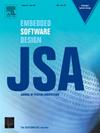面向多机器人系统的可定制冲突解决和基于属性的访问控制框架
IF 4.1
2区 计算机科学
Q1 COMPUTER SCIENCE, HARDWARE & ARCHITECTURE
引用次数: 0
摘要
随着多机器人系统的不断发展并成为各种应用中不可或缺的一部分,管理冲突和确保安全访问控制是需要解决的关键挑战。访问控制在多机器人系统中至关重要,以确保机器人之间安全和授权的交互,保护敏感数据,并防止未经授权的资源访问。本文提出了一种利用Hyperledger Fabric区块链在ROS 2多机器人系统中实现可定制的冲突解决和基于属性的访问控制的新框架。我们引入了一个基于属性的访问控制(ABAC) Fabric-ROS 2桥,以实现用户和机器人之间的安全通信和控制。通过定义基于任务优先级、机器人功能和用户定义约束的冲突解决策略,我们的框架提供了一种解决冲突的灵活方法。此外,它还包含基于属性的访问控制,根据用户和机器人属性授予访问权限。与现有的访问控制方法(如SROS2)相比,ABAC提供了一种模块化的访问控制方法。通过这个框架,多机器人系统可以有效、安全、自适应地管理,确保对资源的控制访问和管理冲突。我们的实验评估表明,与现有的Fabric和ROS 2集成解决方案相比,我们的框架略微改善了延迟和吞吐量。在较高的网络负载下,它是唯一能够可靠运行而不会产生分散的事务提交延迟的解决方案。我们还演示了如何实时解决两个用户同时控制机器人所产生的冲突,并有效地消除了运动失真。本文章由计算机程序翻译,如有差异,请以英文原文为准。
A customizable conflict resolution and attribute-based access control framework for multi-robot systems
As multi-robot systems continue to advance and become integral to various applications, managing conflicts and ensuring secure access control are critical challenges that need to be addressed. Access control is essential in multi-robot systems to ensure secure and authorized interactions among robots, protect sensitive data, and prevent unauthorized access to resources. This paper presents a novel framework for customizable conflict resolution and attribute-based access control in multi-robot systems for ROS 2 leveraging the Hyperledger Fabric blockchain. We introduce an attribute-based access control (ABAC) Fabric-ROS 2 bridge to enable secure communication and control between users and robots. By defining conflict resolution policies based on task priorities, robot capabilities, and user-defined constraints, our framework offers a flexible way to resolve conflicts. Additionally, it incorporates attribute-based access control, granting access rights based on user and robot attributes. ABAC offers a modular approach to control access compared to existing access control approaches in ROS 2, such as SROS2. Through this framework, multi-robot systems can be managed efficiently, securely, and adaptably, ensuring controlled access to resources and managing conflicts. Our experimental evaluation shows that our framework marginally improves latency and throughput over exiting Fabric and ROS 2 integration solutions. At higher network load, it is the only solution to operate reliably without a diverging transaction commitment latency. We also demonstrate how conflicts arising from simultaneous control or a robot by two users are resolved in real-time and motion distortion is effectively eliminated.
求助全文
通过发布文献求助,成功后即可免费获取论文全文。
去求助
来源期刊

Journal of Systems Architecture
工程技术-计算机:硬件
CiteScore
8.70
自引率
15.60%
发文量
226
审稿时长
46 days
期刊介绍:
The Journal of Systems Architecture: Embedded Software Design (JSA) is a journal covering all design and architectural aspects related to embedded systems and software. It ranges from the microarchitecture level via the system software level up to the application-specific architecture level. Aspects such as real-time systems, operating systems, FPGA programming, programming languages, communications (limited to analysis and the software stack), mobile systems, parallel and distributed architectures as well as additional subjects in the computer and system architecture area will fall within the scope of this journal. Technology will not be a main focus, but its use and relevance to particular designs will be. Case studies are welcome but must contribute more than just a design for a particular piece of software.
Design automation of such systems including methodologies, techniques and tools for their design as well as novel designs of software components fall within the scope of this journal. Novel applications that use embedded systems are also central in this journal. While hardware is not a part of this journal hardware/software co-design methods that consider interplay between software and hardware components with and emphasis on software are also relevant here.
 求助内容:
求助内容: 应助结果提醒方式:
应助结果提醒方式:


